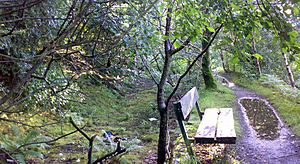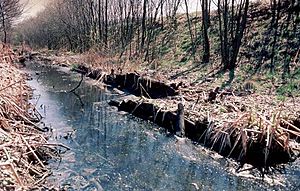Fletcher's Canal facts for kids
Quick facts for kids Fletcher's Canal |
|
|---|---|

Fletcher's Canal showing Clifton Viaduct in the distance. Pilkington's factory is on the right.
|
|
| Specifications | |
| Locks | 2 |
| Status | Closed |
| History | |
| Principal engineer | Matthew Fletcher |
| Date completed | 1800 |
| Date closed | 1952 |
| Geography | |
| Branch of | Manchester Bolton & Bury Canal |
Fletcher's Canal was a waterway about 2.4 kilometers (1.5 miles) long in Greater Manchester, England. It connected the Wet Earth Colliery (a coal mine) to the Manchester Bolton & Bury Canal. This canal was very important for moving coal from the mine. Today, the canal is no longer used and is mostly overgrown.
The canal was built on the south side of the River Irwell. It runs through an area that is now known as Clifton Country Park. If you visit the park, you can still see long parts of the canal, especially west of the old Pilkington's factory. However, these sections no longer hold water. A walking path follows the old towpath (the path where horses would pull boats) through Clifton Country Park. Some of the original parts of the canal are still visible, but they are in poor condition.
Canal History
Early Water Power
Between 1752 and 1756, a clever engineer named James Brindley came up with a way to pump water out of the nearby Wet Earth Colliery. He used the power of the River Irwell by building a water wheel. This wheel helped keep the mine from flooding.
Building the Canal
Around 1790 or 1791, Matthew Fletcher began making some of Brindley's original water channels wider. His goal was to create a new canal, which later became known as Fletcher's Canal. In 1799, Benjamin Outram added a lock to the canal. This lock helped control the water level and prevent too much water from being taken from the river. The canal was finished and ready for boats by 1800.
Canal's Later Years
In 1867, the original water wheel built by Brindley was taken out of service. It was replaced with a more modern water turbine. Later, in 1924, this turbine was replaced by a steam pump. The Wet Earth Colliery coal mine closed down in 1928. Because the mine was no longer operating, the canal was closed and abandoned in 1952.



